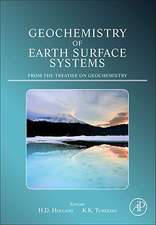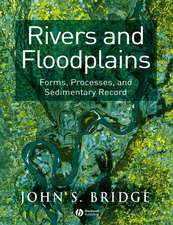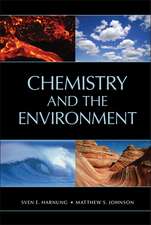Environmental Consequences of War and Aftermath: The Handbook of Environmental Chemistry, cartea 3 / 3U
Editat de Tarek A. Kassim, Damià Barcelóen Limba Engleză Hardback – 7 apr 2009
| Toate formatele și edițiile | Preț | Express |
|---|---|---|
| Paperback (1) | 1721.50 lei 6-8 săpt. | |
| Springer Berlin, Heidelberg – 23 aug 2016 | 1721.50 lei 6-8 săpt. | |
| Hardback (1) | 1729.74 lei 6-8 săpt. | |
| Springer Berlin, Heidelberg – 7 apr 2009 | 1729.74 lei 6-8 săpt. |
Din seria The Handbook of Environmental Chemistry
- 18%
 Preț: 1723.03 lei
Preț: 1723.03 lei - 18%
 Preț: 1730.46 lei
Preț: 1730.46 lei - 18%
 Preț: 1978.60 lei
Preț: 1978.60 lei - 18%
 Preț: 2349.97 lei
Preț: 2349.97 lei -
 Preț: 1465.22 lei
Preț: 1465.22 lei - 18%
 Preț: 1158.66 lei
Preț: 1158.66 lei - 5%
 Preț: 1344.41 lei
Preț: 1344.41 lei - 15%
 Preț: 605.68 lei
Preț: 605.68 lei -
 Preț: 361.96 lei
Preț: 361.96 lei - 5%
 Preț: 1333.35 lei
Preț: 1333.35 lei - 15%
 Preț: 606.90 lei
Preț: 606.90 lei -
 Preț: 372.36 lei
Preț: 372.36 lei - 5%
 Preț: 1349.46 lei
Preț: 1349.46 lei - 15%
 Preț: 605.98 lei
Preț: 605.98 lei - 5%
 Preț: 1348.04 lei
Preț: 1348.04 lei -
 Preț: 365.78 lei
Preț: 365.78 lei - 5%
 Preț: 347.33 lei
Preț: 347.33 lei - 15%
 Preț: 607.69 lei
Preț: 607.69 lei - 5%
 Preț: 1341.82 lei
Preț: 1341.82 lei - 15%
 Preț: 610.80 lei
Preț: 610.80 lei - 5%
 Preț: 681.09 lei
Preț: 681.09 lei - 5%
 Preț: 676.94 lei
Preț: 676.94 lei -
 Preț: 369.06 lei
Preț: 369.06 lei - 5%
 Preț: 678.30 lei
Preț: 678.30 lei - 15%
 Preț: 608.61 lei
Preț: 608.61 lei - 18%
 Preț: 690.42 lei
Preț: 690.42 lei - 18%
 Preț: 1734.99 lei
Preț: 1734.99 lei - 5%
 Preț: 1823.54 lei
Preț: 1823.54 lei - 18%
 Preț: 1161.04 lei
Preț: 1161.04 lei -
 Preț: 365.78 lei
Preț: 365.78 lei - 18%
 Preț: 693.99 lei
Preț: 693.99 lei - 15%
 Preț: 609.22 lei
Preț: 609.22 lei - 5%
 Preț: 1346.53 lei
Preț: 1346.53 lei -
 Preț: 372.36 lei
Preț: 372.36 lei - 18%
 Preț: 1165.84 lei
Preț: 1165.84 lei -
 Preț: 363.04 lei
Preț: 363.04 lei -
 Preț: 366.15 lei
Preț: 366.15 lei - 18%
 Preț: 1729.86 lei
Preț: 1729.86 lei - 5%
 Preț: 344.88 lei
Preț: 344.88 lei - 18%
 Preț: 1158.80 lei
Preț: 1158.80 lei - 18%
 Preț: 1720.92 lei
Preț: 1720.92 lei
Preț: 1729.74 lei
Preț vechi: 2109.44 lei
-18% Nou
Puncte Express: 2595
Preț estimativ în valută:
331.32€ • 359.44$ • 276.07£
331.32€ • 359.44$ • 276.07£
Carte tipărită la comandă
Livrare economică 04-18 decembrie
Preluare comenzi: 021 569.72.76
Specificații
ISBN-13: 9783540879619
ISBN-10: 3540879617
Pagini: 344
Ilustrații: XII, 325 p.
Dimensiuni: 155 x 235 x 25 mm
Greutate: 0.73 kg
Ediția:2009
Editura: Springer Berlin, Heidelberg
Colecția Springer
Seriile The Handbook of Environmental Chemistry, Anthropogenic Compounds
Locul publicării:Berlin, Heidelberg, Germany
ISBN-10: 3540879617
Pagini: 344
Ilustrații: XII, 325 p.
Dimensiuni: 155 x 235 x 25 mm
Greutate: 0.73 kg
Ediția:2009
Editura: Springer Berlin, Heidelberg
Colecția Springer
Seriile The Handbook of Environmental Chemistry, Anthropogenic Compounds
Locul publicării:Berlin, Heidelberg, Germany
Public țintă
ResearchCuprins
Background to Selected Environmental and Human Health Effects of Chemical Warfare Agents.- Prevention of War and Its Environmental Consequences.- Remote Sensing: Fundamentals, Types and Monitoring Applications of Environmental Consequences of War.- War-Induced Soil Degradation, Depletion, and Destruction (The Case of Ground Fortifications in the Terrestrial Environment of Kuwait).- Critical Assessment of the Environmental Consequences of the Invasion of Kuwait, the Gulf War, and the Aftermath.- Atmospheric Transport and Deposition of Persistent Organic Pollutants Under Warfare Conditions.- Environmental and Health Impact Assessment of Ammunition Containing Transuranic Elements.- Ecological Impact on the Danube After NATO Air Strikes.- Speciation of Heavy Metals in Geological Matter of the Serbian National Parks, Protected Areas and Cities Within the Danube River Basin After the War Conflict in 1999.
Textul de pe ultima copertă
War has disastrous effects on people and the physical, biological, economic, and social environment. The state-of-the-art of research on the environmental consequences of war and its aftermath is presented in this Handbook. A broad range of topics are included, such as the prevention of war and its environmental repercussions and selected environmental and human health effects of chemical warfare agents and the atmospheric transport and deposition of pollutants under warfare with two main case studies: the Balkans and the Gulf war.
This book is of great help in bridging the gap between environmental chemists, who generally have limited experience with Chemical Warfare (CW) issues, with those who work with CW disarmament and nonproliferation issues but tend not to have scientific backgrounds. This book provides the basic background information needed to better grasp the problem of the environmental consequences of war, promotes a greater public awareness of and sensitivity to these issues, and can hopefully contribute to avoiding further wars in future.
This book is of great help in bridging the gap between environmental chemists, who generally have limited experience with Chemical Warfare (CW) issues, with those who work with CW disarmament and nonproliferation issues but tend not to have scientific backgrounds. This book provides the basic background information needed to better grasp the problem of the environmental consequences of war, promotes a greater public awareness of and sensitivity to these issues, and can hopefully contribute to avoiding further wars in future.
Caracteristici
Includes supplementary material: sn.pub/extras









